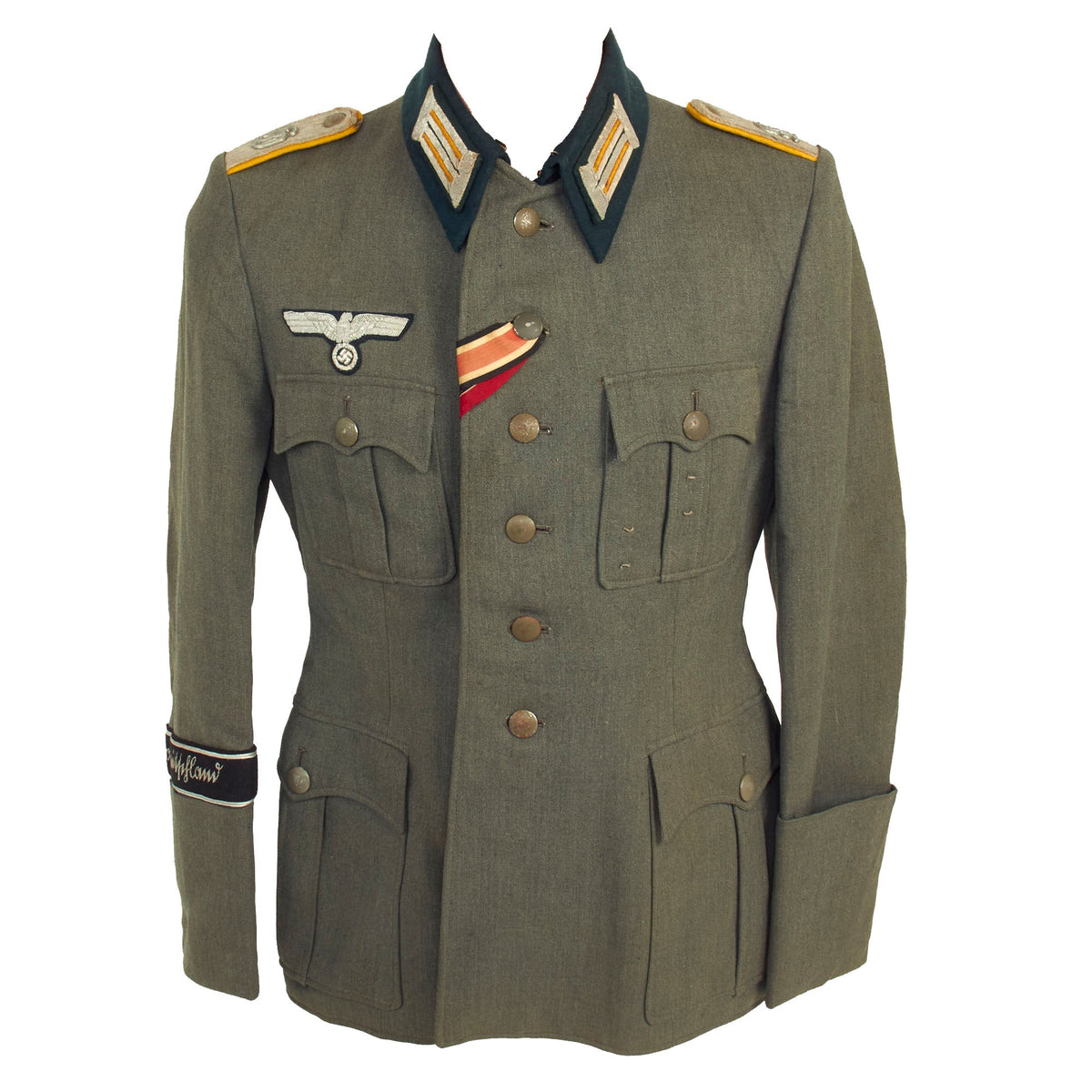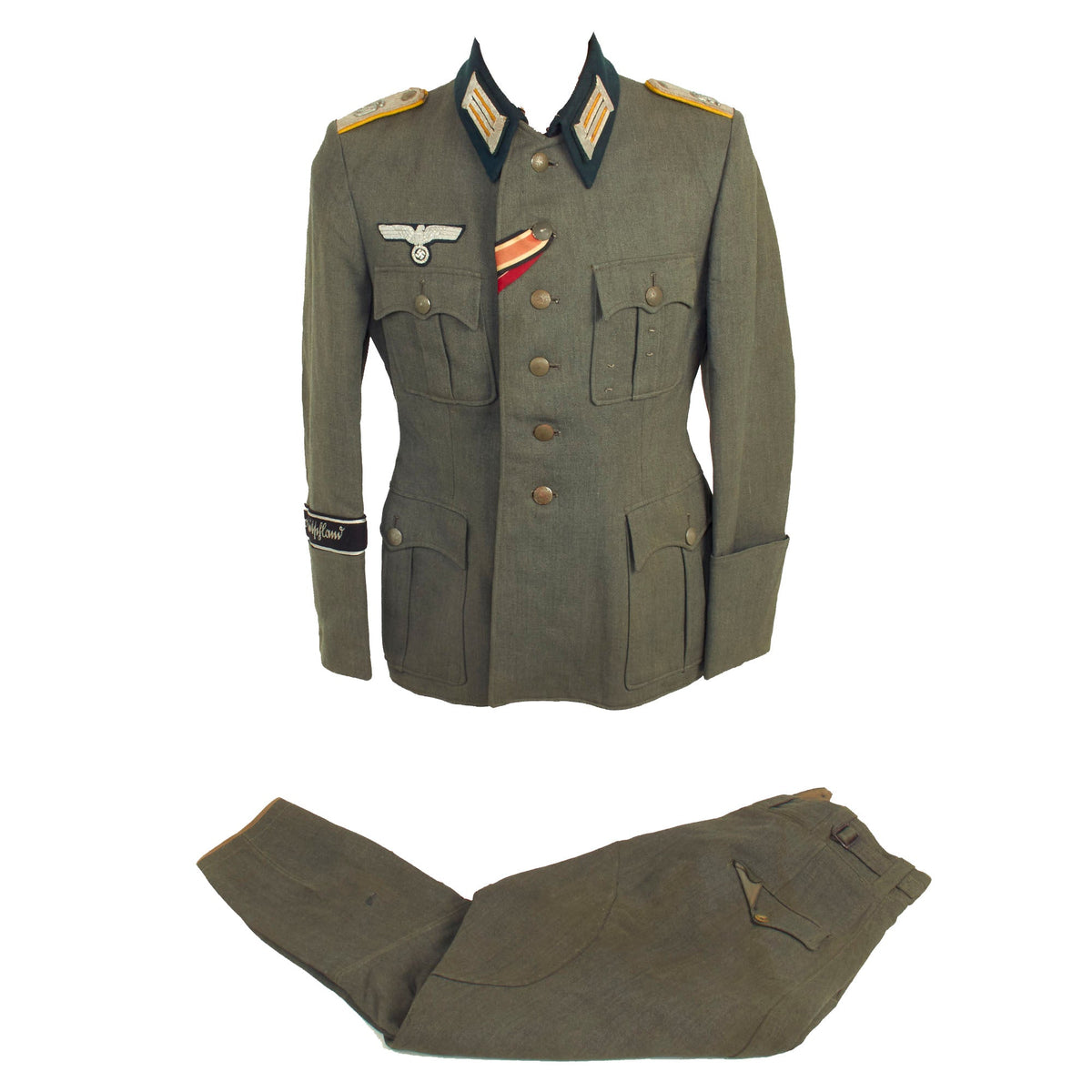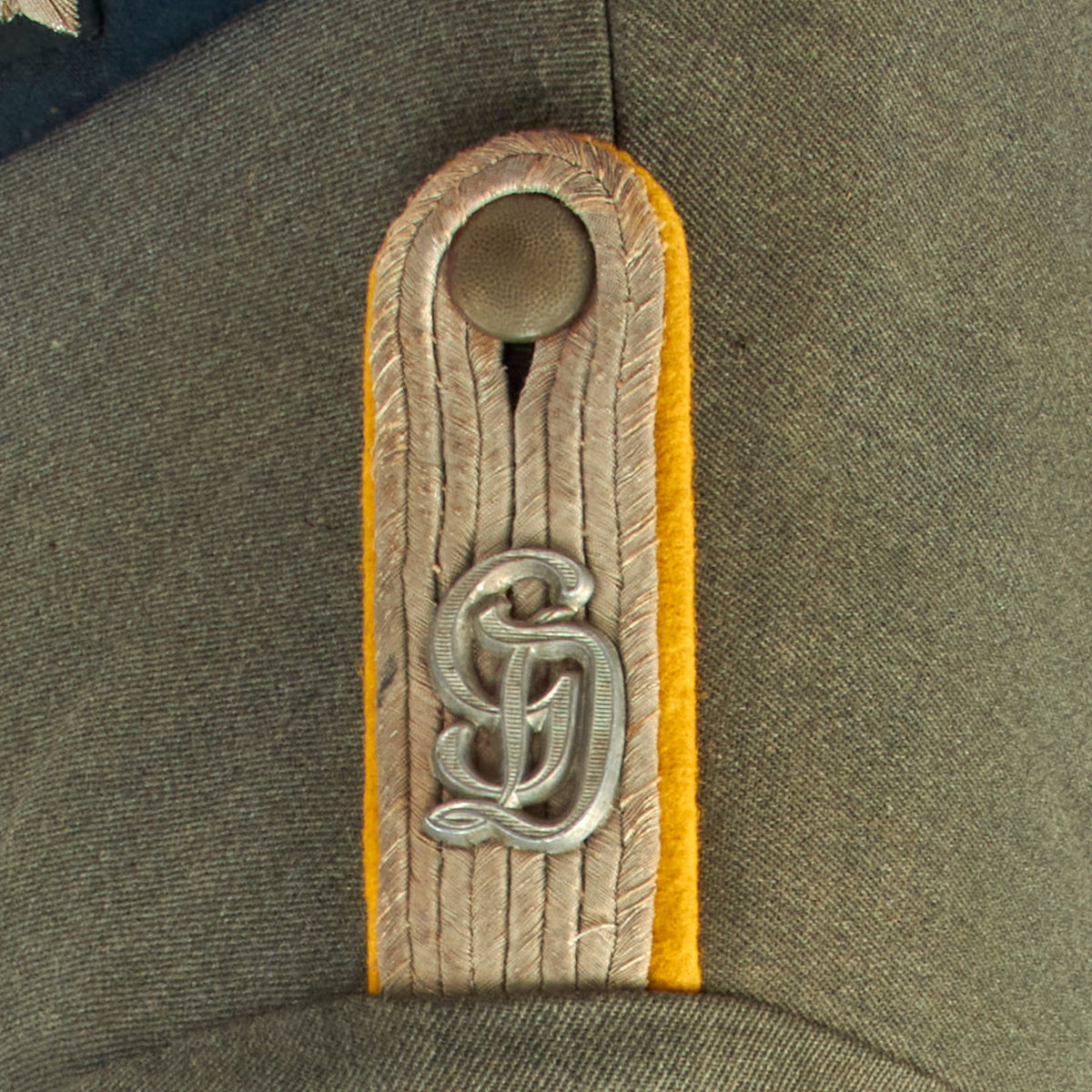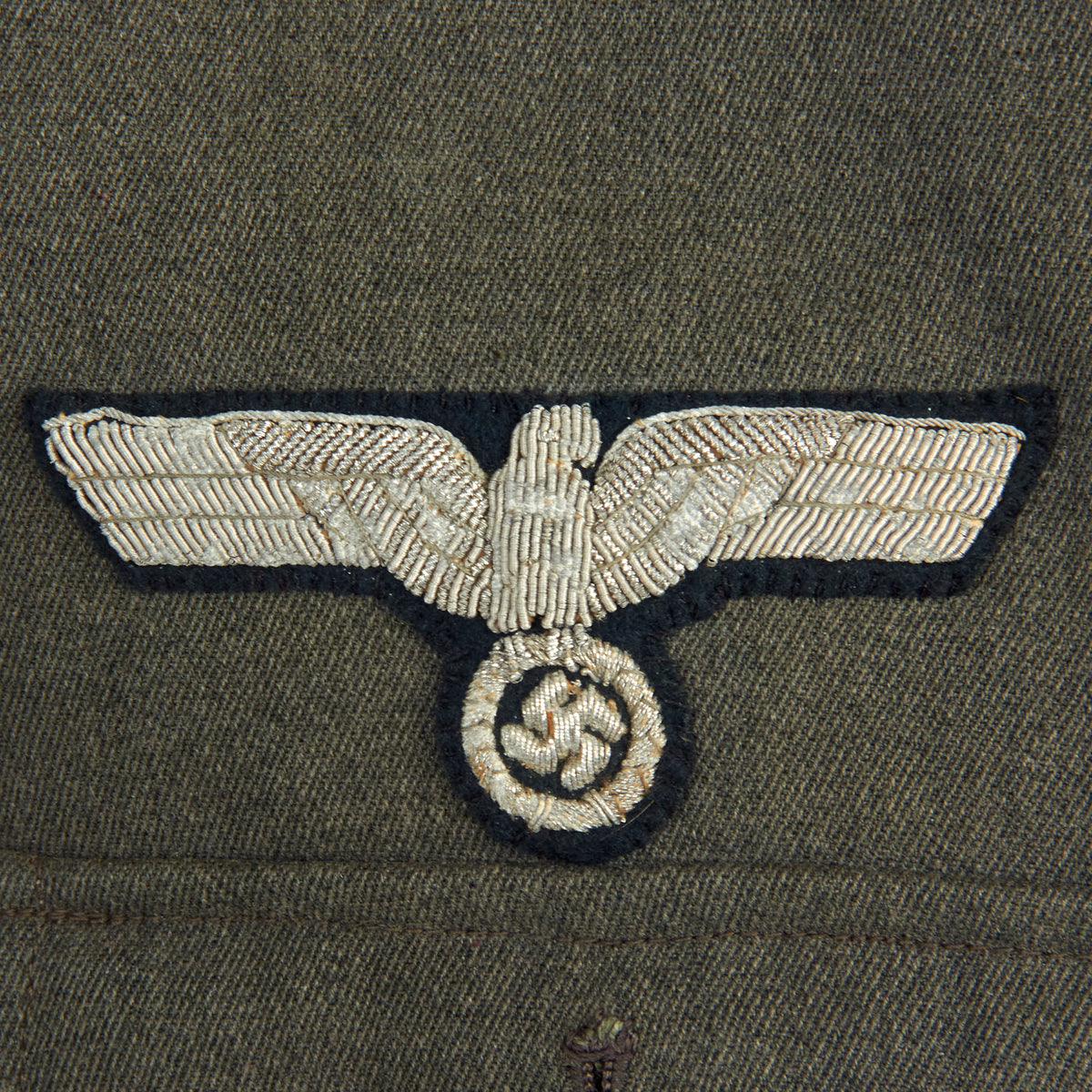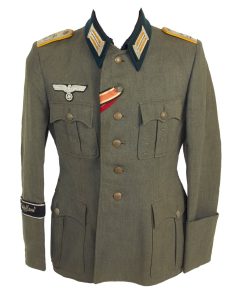Original German WWII Heer Army Großdeutschland Division Reconnaissance Officer’s M36 Field Tunic with Breeches Original Items
$ 3.895,00 $ 973,75
Original Items: Only One Set Available. The Panzergrenadier Division “Großdeutschland”, also commonly referred to simply as “Großdeutschland” or “Großdeutschland Division”, was an elite combat unit of the German Army (Heer) that fought on the Eastern Front in World War II.
This exact uniform was sold by Herman Historica in 2017 for more than $6000 as seen at this link.
Originally formed in 1921 it was known as the Wachregiment Berlin and served as a ceremonial guard unit and by 1939 had grown into a regiment of the combined Wehrmacht German armed forces. The regiment would later be expanded and renamed “Infantry Division Großdeutschland” in 1942, and after significant reorganization was renamed Panzergrenadier Division Großdeutschland in May 1943. In November 1944, while the division retained its status as a panzergrenadier division, some of its subordinate units were expanded to divisional status, and the whole group of divisions were reorganized as Panzerkorps Großdeutschland.
This is a very nice early pattern German WWII Heer Army M-36 Tunic, showing moderate wear from service and in very good display condition. There is no maker mark on the interior, or other markings, so this was most likely custom made for the officer at a local tailor. The tunic features four pockets with scalloped flaps and green painted pebbled aluminum buttons, and has a six button front closure, with two “hook and loop” fasteners for the collar. The buttons on the tunic are sewn directly to the fabric, not attached with metal circlips, and all show light wear to the paint. All of the buttons look to be original, and are maker marked on the rear.
The interior is lined with lovely gray HBT rayon, with very soft light gray rayon in the sleeves. There is an interior pocket inside the left breast, and a hanger clip for an officer’s dagger, which would attach through the lower left pocket. There are a few tears and some light staining, but the interior is really in good shape otherwise.
It is adorned with the usual rank and branch insignia used on German tunics. The attractive Army breast eagle is the correct officer’s silver bullion hand embroidered type on a green background, and is very neatly hand stitched to the chest in a fashion typical of wartime German tailor work. It is only stitched to the outer layer of fabric, indicating installation when the uniform was made, so it has never been replaced.
The left sleeve has a lovely third pattern black Großdeutschland cuff title, with machine embroidered Sütterlin style script in silver. It has the correct piping, which was on all of these cuff titles, not just those used on officer’s uniforms, as often asserted. It is hand stitched to the sleeve around the entire circumference, and we have compared it to period examples, and it matches the pattern exactly.
The collar is wrapped in a dark-green wool, has officer’s field litzen collar patches on each side, which are woven from silver bullion thread with a dark green background matching the collar. The colored stripes on each are Goldgelb (Golden-Yellow), the Waffenfarbe (corps color) for Cavalry, as well as reconnaissance and armored reconnaissance units with cavalry traditions. This would indicate they were a member of the Großdeutschland Reconnaissance Battalion. The collar is in good shape, tough there is a bit of wear around the edges, which is usually one of the first places to show damage from use.
The “sew-in” style company officers schulterklappen (shoulder boards) of this tunic are constructed with two rows of fine silver flatware “Russia Braid” double piping and have the correct yellow piping around the edges. There are no rank “pips” installed, indicating the lowest officer rank of Leutnant (Lieutenant). They also have lovely metal interlocking GD monograms attached, for the Großdeutschland division. The second buttonhole from the top on the tunic has the ribbons for an Iron Cross 1939 2nd Class and Eastern Front medal installed. There are also some thread loops on the pocket underneath, so there are awards that the German soldier removed, probably to put on another uniform.
Overall condition is very good, with just a bit of light wear and staining consistent with service. There is a bit of mothing on the collar, and some staining and wear to the shoulder boards, but nothing out of the ordinary. There are also scattered small pulls on the exterior of the tunic, as expected.
The included matching breeches are made from matching fabric, and are show top quality bespoke construction. They have a button fly closure with fully hidden buttons, with the usual buttons on the inside for suspenders and other attachments. There are two diagonal slash pockets on the hips, with button closed pockets on the seat, and a small button closed pocket near the fly. The bottoms of the legs have button closures, so that the feet could fit through easier before the bottoms would be closed and tall boots worn. Condition is very good, with just a few small moth nips here and there, and some small holes in the rear due to wear.
A really fantastic Uniform set from a legendary division of the German Wehrmacht, totally correct and ready to display as is or dress up a bit with some great awards. Ready to display!
Approximate Measurements:
Collar to shoulder: 9″
Shoulder to sleeve: 25”
Shoulder to shoulder: 16”
Chest width: 17.5″
Waist width: 16″
Hip width: 20”
Front length: 28″
Pants:
Waist: 17″
Inseam: 24.5″
More History On The Großdeutschland Division
The Infantry Regiment Grossdeutschland was activated on 14 June 1939. The regiment saw action in France in 1940. It was attached to Panzer Group 2 in the opening phases of Barbarossa, and was nearly destroyed in the Battle of Moscow in late 1941. On the last day of February 1942, the remnants of the regiment absorbed two battalions of reinforcements that arrived from Neuruppin and the regiment was reconstituted. It later moved to Orel, and on 1 April 1942 the former Infantry Regiment Großdeutschland was reinforced and expanded into the Infanterie-Division Großdeutschland (mot.) (motorized Infantry Division Grossdeutschland) using newly arrived troops from Germany.
The division was assigned to XXXXVIII Panzer Corps during the opening phases of Fall Blau, the Wehrmacht’s 1942 strategic summer offensive in southern Russia. During the combined Soviet winter offensives Operation Uranus and Operation Mars, the division fought near Rzhev, where it was rendered combat ineffective.
In January–February 1943, Großdeutschland and XXXXVIII Panzer Corps, along with the II SS Panzer Corps took part in the Third Battle of Kharkov. The division fought alongside the 1st SS Division Leibstandarte SS AH, 2nd SS Division Das Reich and 3rd SS Division Totenkopf during these battles. After the conquest of Kharkov, the Großdeutschland was again pulled back and refitted.
On 19 May 1943, with the addition of armoured personnel carriers and Tigers the division was redesignated Panzergrenadier Division Großdeutschland (Armored Infantry Division Grossdeutschland), though in reality it now had more armoured vehicles than most full-strength panzer divisions.
The newly re-equipped division was subordinated to the XXXXVIII Panzer Corps, part of Fourth Panzer Army, and took part in the Battle of Kursk. During the buildup period, a brigade of two battalions was equipped with the new Panther tanks, which were plagued by technical problems, suffering from engine fires and mechanical breakdowns before reaching the battlefield. By 7 July, the division had only 80 of its 300 tanks still fit for combat. After the Kursk offensive was cancelled, the division was transferred back to Army Group Center, and resumed its role as a mobile reserve. The Tiger I tank company was expanded to a battalion, becoming the III. Battalion of the Panzer Regiment. Großdeutschland saw heavy fighting around Karachev before being transferred back to XLVIII Panzer Corps in late August. For the rest of 1943, Großdeutschland retreated across Ukraine, and in 1944 into Romania, where it took part in the First Battle of Târgu Frumos.
In early August, the division was transferred to East Prussia from Army Group South Ukraine. Over the next months, Großdeutschland was involved in heavy fighting in both East Prussia, including a counter-attack on Wilkowischken and the Baltic States, suffering high casualties in both men and materiel. The division was nearly destroyed during the battles in the Memel bridgehead.
In November 1944, while the division and several attached units were redesignated as Panzerkorps Großdeutschland. By March 1945, the Panzer Grenadier Division Großdeutschland had been reduced to around 4,000 men after the Battle of Memel. By 25 April 1945, the division was engaged in heavy fighting in the battles around Pillau. Eight hundred men of the division were evacuated on ferries via the Baltic Sea and surrendered to British forces in Schleswig-Holstein on May 9. The rest were either killed or captured during the fighting in Pillau or surrendered to Soviet forces on May 9 on the Vistula spit.
Terms such as M40 and M43 were never designated by the Wehrmacht, but are names given to the different versions of the Model 1936 field tunic by modern collectors, to discern between variations, as the M36 was steadily simplified and tweaked due to production time problems and combat experience.
Field Tunic (Feldbluse) Model 1936
When the NSDAP came to power in early 1933 the Reichswehr, the armed forces of the Weimar Republic, were near the end of a two-year project to redesign the Army Feldbluse (field-blouse). Beginning in that year the new tunic was issued to the Reichsheer and then the rapidly growing Wehrmacht Heer, although minor design changes continued to be made until the appearance of the standardized Heeres Dienstanzug Modell 1936. The M36 tunic still retained the traditional Imperial and Reichswehr uniform color of grey-green “field gray” (feldgrau) wool, but incorporated four front patch pockets with scalloped flaps and pleats (on Reichswehr tunics the lower pockets were internal and angled). The front was closed with five buttons rather than the previous eight, and the collar and shoulder straps were of a dark bottle-green instead of the Reichswehr grey. Compared to the Weimar-era uniforms the skirt of the feldbluse was shorter and the tailoring was more form-fitting due to Germany’s adoption of mechanized warfare: soldiers now spent much time in the confined space of a vehicle and a shorter jacket was less likely to pick up dirt from the seats. It also included an internal suspension system, whereby a soldier could hang an equipment belt on a series of hooks outside of the tunic. These hooks were connected to two straps inside the lining, which spread the weight of equipment without having to use external equipment suspenders. The M36 was produced and issued until the very end of the war, though successive patterns became predominant.
SS field uniforms were of similar appearance externally but to fit their larger patches had a wider, feldgrau collar, and the lower pockets were of an angled slash type similar to the black or grey SS service-dress. The second button of an SS Feldbluse was positioned somewhat lower, so that it could be worn open-collar with a necktie. Due to supply problems the SS were often issued army uniforms.
Fast Shipping with Professional Packaging
Thanks to our longstanding association with UPS FedEx DHL, and other major international carriers, we are able to provide a range of shipping options. Our warehouse staff is expertly trained and will wrap your products according to our exact and precise specifications. Prior to shipping, your goods will be thoroughly examined and securely secured. We ship to thousands clients each day across multiple countries. This shows how we're dedicated to be the largest retailer on the internet. Warehouses and distribution centres can be located throughout Europe as well as the USA.
Note: Orders with more than one item will be assigned a processing date depending on the item.
Before shipping before shipping, we'll conduct a thorough inspection of the items you have ordered. Today, the majority of orders will be delivered within 48 hours. The delivery time will be between 3-7 days.
Returns
The stock is dynamic and we cannot completely manage it because multiple stakeholders are involved, including our factory and warehouse. So the actual stock may alter at any time. It's possible that you may not receive your order once the order has been made.
Our policy is valid for a period of 30 days. If you don't receive the product within 30 days, we are not able to issue a refund or an exchange.
You can only return an item if it is unused and in the same state as the day you received it. You must have the item in its original packaging.
Related products
Uncategorized
Armoured Fighting Vehicles of the World: AFVs of World War One (Hardcover Book) New Made Items
Uncategorized
Uncategorized
Uncategorized
Uncategorized
Uncategorized
Uncategorized
Uncategorized
Band of Brothers ORIGINAL GERMAN WWII Le. F.H. 18 10.5cm ARTILLERY PIECE Original Items
Uncategorized
Uncategorized
Uncategorized
Uncategorized
Uncategorized
Uncategorized
Uncategorized
Uncategorized
Uncategorized
